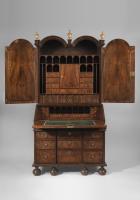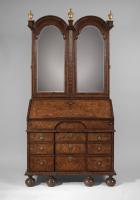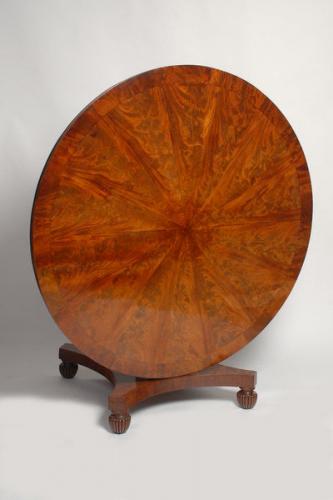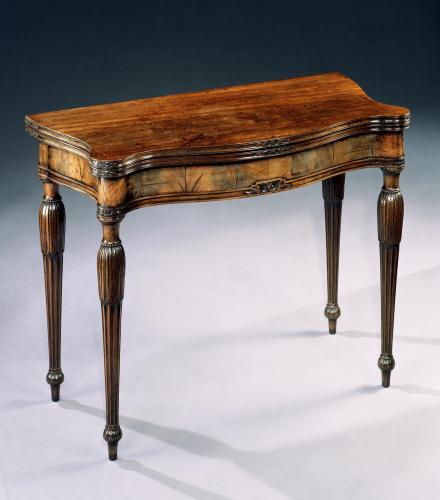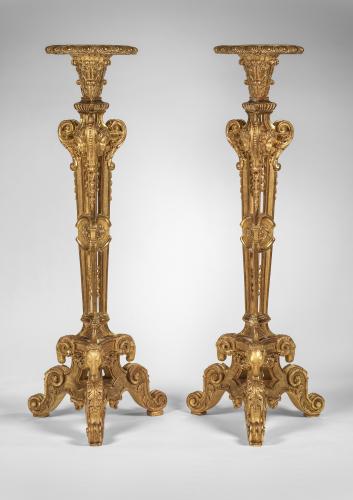
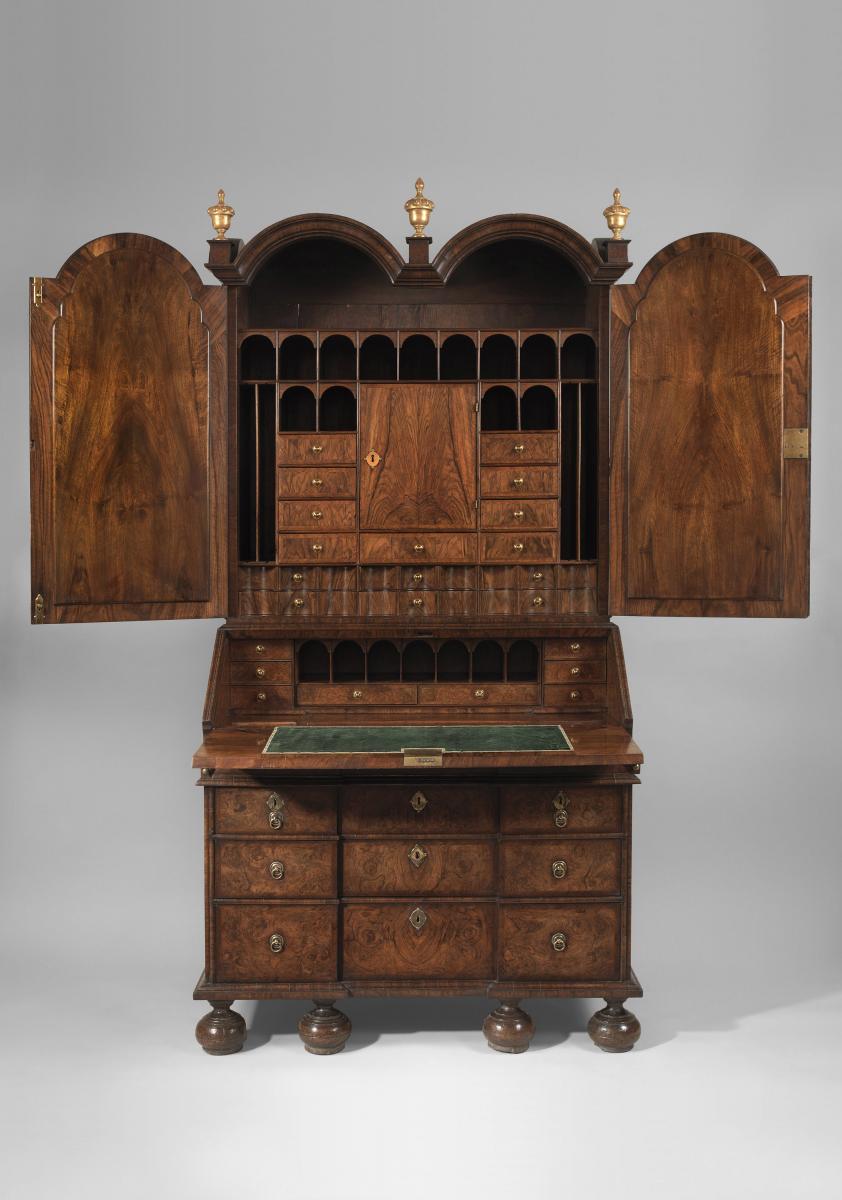
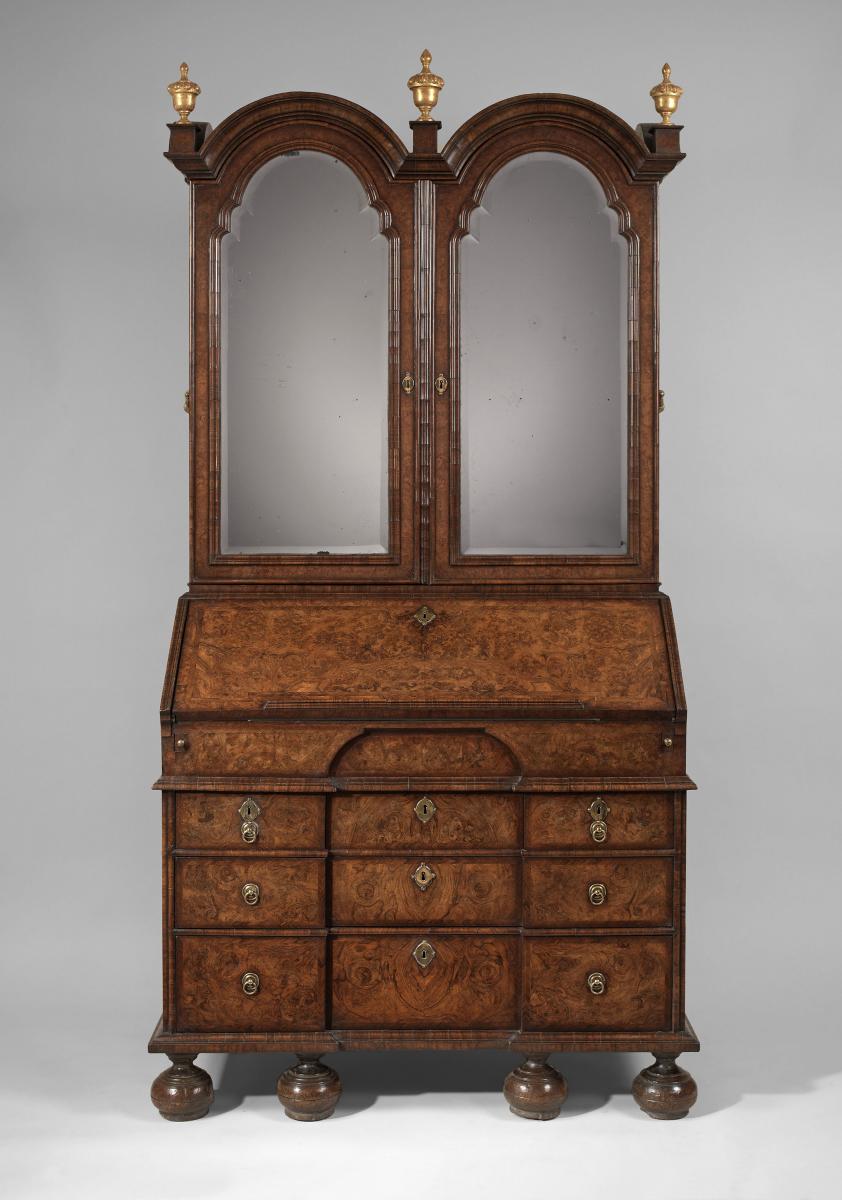
Price on application
This object is eligible for a Certificate of BADA Provenance
The BADA Standard
- Since 1918, BADA has been the leading association for the antiques and fine art trade
- Members are elected for their knowledge, integrity and quality of stock
- Our clients are protected by BADA’s code of conduct
- Our dealers’ membership is reviewed and renewed annually
- Bada.org is a non-profit site: clients deal directly with members and they pay no hidden fees
George I Bureau Bookcase Attributed to Peter Miller.
Circa 1720.
43.5 x 25 x 89 in (111 x 63 x 227 cm)
In three parts, the upper section with double domed top and domed sides with a larger gilt urn finial in the centre flanked by smaller gilt urn finials on the corners, above a pair of arched mirror doors. Opening to an interior fitted with valenced pigeonholes above a central door opening to a recess and drawers flanked by flat-faced drawers above curved drawers. The middle section with a richly veneered fall front opening to a central fitted pull out section with hidden drawers at the rear and flanked by drawers to the sides. Also fitted with three sliding panels opening to reveal a secret well with hidden drawers concealed at the front. The frieze with a central arched broken front. The bottom section with moulded waist and two short and one inset drawer over two long graduated drawers, the sides with conforming carrying handles. Raised on six original bun feet and retaining its original brass handles and mounts.
At the time of writing Adam Bowett records that there are six pieces of furniture, which might reasonably be attributed to Miller, this bookcase being one of them. Aside from the similarities in form, style and metalware, which link them, they also share common quirks of construction and materials. All are made exclusively of walnut veneer on wainscot oak of the highest quality. No deal whatsoever is used in their construction, which is unusual even on the best English pieces of this date. The construction, while ostensibly conventional, is unusually precise, with an ‘engineered’ quality. The small interior drawers of the desks all have their sharp edges radiussed or ‘softened’, an unusual and rather personal touch. Several pieces evince a preoccupation with security and secrecy, not only in their multitude of secret drawers, but in the unusual locks which are of the highest technical standard. The locks to at least three of the desk slopes have false covers, which conceal all fixings, making them virtually impossible to remove. One cabinet has iron brackets in the upper doors, which engage with the carcase sides to prevent the doors being forced. Common to all the desks in the group is a moulding of a curious profile, which flanks each side of the slope.
Known works of Peter Miller identified by Adam Bowett:
1. A signed and dated piece that emerged on the Spanish antiques market about 1982 and bought by Jeremy and sold to a private client. Prior to that it had been in private hands in Spain since the early 19th century.
2. A desk-and-bookcase in the collection of Bristol City Arts Galleries and Museums, at Red Lodge, Bristol.
This is so similar in form and style to the signed version as to admit of little doubt of its authorship. The only significant exterior differences are in the design of the drawer pulls and the feet, which are straightforward ball feet, rather than the ball-and-bracket of the signed piece. The layout and construction of the desk interior is identical, even to the arrangement of the multitude of secret drawers, and it has the same curious moulding profile either side of the fall. However, two things suggest that this desk-and-bookcase might be slightly earlier in date than the signed one. First, the use of a standard turned foot rather than the more sophisticated ball-and-bracket of the signed piece. Second, the drawers in the lower carcase have nailed-up bottoms with added runners, whereas those on the signed piece have both bottoms and runners rebated into the sides. The former type of construction is typical of London work between c.1700 and c.1720, whereas the latter only came into general use during the 1720s.
3. A desk that has passed through the English trade at various times, including the stock of Phillips of Hitchin (1972). It was sold by them to an American collector, and is thought to be still in his collection.
This desk is identical in form to the lower half of no. 2, and the interior arrangement is also identical. Details of drawer construction are not known, but the similarity of metalware and the plain ball feet suggest a similar date to the Red Lodge desk-and-bookcase. As well as these common features the desk has the same distinctive moulding either side of the fall.
4. The above described piece currently owned by Frank Partridge. This piece has the same tripartite lower case as nos 1, 2 & 3, but with a simplified desk interior. It has the distinctive mouldings either side of the slope. The upper case has an arrangement of drawers and pigeonholes about a central cupboard, which is less complex than on 1 & 2. The shaped arched mirrors are similar to 1 & 2. Metalwork is identical to that on 1, 2 & 3.
5. A cabinet sold by Christies, London, 13 November 1997, lot 160, and now in a private English collection. This cabinet, although very different in form from the previous examples, exhibits a number of characteristic Miller attributes. Externally, the first clue is provided by the design of the carrying handles, which matches that used on the other three pieces. The profile of the moulding beside the fall is also identical. The interior drawers of both upper and lower carcase have the same high-quality ring handles as used on nos 1, 2, 3 & 4. The most compelling similarities, however, are in the interior of the desk, where the layout of the drawers and pigeonholes is a simplified version of the Red Lodge piece. The feet are replaced, but were originally ball or bun feet.
6. A desk-and-bookcase, sold Sotheby’s, London.
This desk-and-bookcase is a more conventional article than nos. 1-5. The bookcase has a double-arched cornice and two glazed doors enclosing a plain, shelved interior with two drawers in the base. It has, however, the characteristic moulding beside the slope and a rather curious moulding around the mirrors, which is similar. The shape of the mirror plates is the same as on no. 4. The interior is identical in layout to the Christie’s cabinet, except that the pigeonholes have arched tops. The brassware is the same as those used on all other examples. The lower carcase is conventionally arranged, with two short and two long drawers below the well. The drawer handles match those found on other Miller pieces, but the locks are steel rather than brass. This is consistent with the generally more modest character of the piece.
7. A desk made for Peter the Great in 1717, and now in the Hermitage Museum, St Petersburg. Adam Bowett has not yet seen this piece, so this attribution remains tentative. The brassware is identical to other ‘Miller’ pieces, as is the layout of the desk interior. The proportions of this desk are unusual, but this is explained by the fact that Peter the Great was unusually tall. According to the authorities at St Petersburg
In addition to these English pieces there are striking stylistic analogies with several contemporary Dutch desks-and-bookcases. One is in the Rijksmuseum, Amsterdam (illus. Hayward, World Furniture, fig. 240.) and Bonham’s and Butterfield, San Francisco, 30 October 2006, lot 1543, sold another. While the surface decoration of both these pieces is very different from the English examples (both being parquetry decorated), the tripartite form of the lower case is distinctive. In the case of the Bonham’s and Butterfield example, the pediment design and the placing of the central small mirror in the upper case suggest a direct link with Miller, either from a common design source or from a common training. However, it is significant that both these Dutch examples have some technical differences and very different metal ware from the English Miller group, strongly suggesting they do not emanate from the same workshop.
Peter Miller:
Peter Miller’s work was unknown to English furniture historians and dealers at large until the publication in 1996 of Christopher Gilbert’s Marked London Furniture. Gilbert illustrated (p. 337, figs. 646-7) a fine walnut veneered desk-and-bookcase inscribed ‘Peter Miller Cabenet Macker in the Savoy in London the 13 June Ao 1724’. The inscription was hidden behind a small mirror in the centre of the upper case between the two doors, and was only discovered because the mirror had recently been broken in transit and needed replacing.
Since 1996 a handful of other pieces attributable to Miller have come to light, but the man himself remains something of an enigma. The inscription cited above states that Miller worked in the area of London called the Savoy. The Savoy was sandwiched between the north bank of the Thames and the Strand, and separated the City of London from Westminster. It enjoyed a large degree of independence from the jurisdictions of the City, and among the freedoms enjoyed by its inhabitants was the absence of any oversight by the London Livery Companies. This probably explains why Miller’s name does not appear in any Livery Company archives and is also one of the reasons why Miller is so hard to document.
Peter Miller ‘Cabenet Macker’, is likely to be the same Peter Miller who on 28 May 1715 signed a marriage allegation declaring his intention to marry Ann Klug, a widow of about 38 years old who lived in the parish of St Martin-in-the-Fields. The name ‘Klug’ was perhaps a phonetic rendering of ‘Klark’ or ‘Clark’. The allegation describes Miller as a resident of the parish of St Mary le Savoy, aged ‘about fifty years’, which suggests he was born about 1665, although no record of his birth has so far been found.
Miller’s wife had two sons by a previous marriage, William and Jonas Klark, described in Miller’s will as his sons-in-law. Apart from the marriage allegation, the will is the only extant document relating to Miller’s life. It is dated 17 September 1729. In it Miller describes himself as a ‘Cabinet Maker’, in ill health ‘but of a sound and disposing Mind and Memory’. He was about sixty five years old, and it appears he was not a rich man. There is no mention of Miller’s wife Anne, who must have died, but she left him two young daughters, Ann and Elizabeth. To his stepson William Klark he left five pounds ‘to buy him Morning [sic]’ and to Jonas a shilling. It appears there was little love lost between father and stepsons. Miller left ten pounds, plus bedding and other furniture, to his serving maid Mary Stening. To his kinsman John Miller he left five pounds for mourning apparel and stipulated that John was to have his ‘Trade and Business of Cabinet Making’, provided he paid for all tools and utensils as was customary. This John Miller was probably the same man who is recorded between 1711 and 1718 as paying a hearth tax of 10 shillings for a property in Fountain Court, Savoy. Fountain Court was on the west side of the Savoy, within the Parish of St Mary le Savoy. From this it is clear that John and Peter lived and worked in close proximity, possibly in the same workshop, for Peter is not recorded paying any hearth tax.
Miller’s two daughters were still minors, and he directed that after the sale of all his goods and chattels the money realised should be put out at interest and the income used to maintain and educate them until they were twenty-one, or until they were married. As executors and guardians of his daughters he nominated two friends, John Courot, an ‘Eye Maker’, and John Blow.
The BADA Standard
- Since 1918, BADA has been the leading association for the antiques and fine art trade
- Members are elected for their knowledge, integrity and quality of stock
- Our clients are protected by BADA’s code of conduct
- Our dealers’ membership is reviewed and renewed annually
- Bada.org is a non-profit site: clients deal directly with members and they pay no hidden fees


